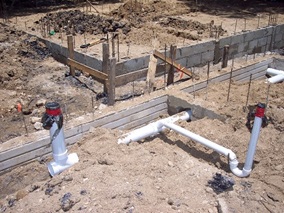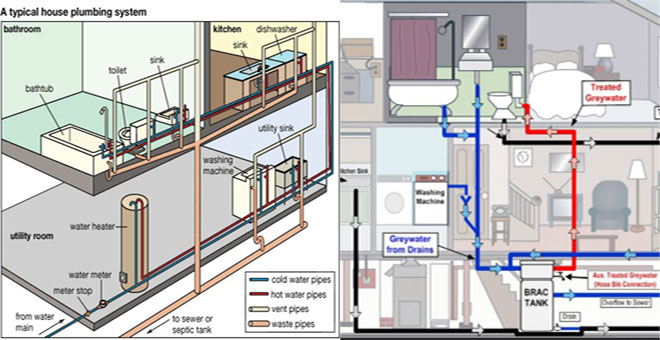How Your Home's Plumbing System Works: Anatomy
How Your Home's Plumbing System Works: Anatomy
Blog Article
How do you really feel with regards to Understanding Your Home's Plumbing Anatomy?

Understanding how your home's plumbing system works is crucial for every property owner. From supplying tidy water for alcohol consumption, food preparation, and showering to securely getting rid of wastewater, a properly maintained pipes system is crucial for your family's health and comfort. In this extensive guide, we'll explore the complex network that composes your home's pipes and deal ideas on upkeep, upgrades, and dealing with typical issues.
Intro
Your home's pipes system is more than simply a network of pipes; it's a complicated system that ensures you have accessibility to tidy water and effective wastewater elimination. Recognizing its components and how they work together can help you stop costly repair work and make certain everything runs smoothly.
Basic Elements of a Pipes System
Pipes and Tubing
At the heart of your pipes system are the pipelines and tubes that bring water throughout your home. These can be made of various materials such as copper, PVC, or PEX, each with its benefits in terms of resilience and cost-effectiveness.
Components: Sinks, Toilets, Showers, etc.
Fixtures like sinks, bathrooms, showers, and bathtubs are where water is made use of in your home. Recognizing exactly how these fixtures link to the plumbing system assists in diagnosing troubles and preparing upgrades.
Shutoffs and Shut-off Factors
Valves regulate the flow of water in your pipes system. Shut-off valves are critical during emergencies or when you require to make repair work, permitting you to isolate parts of the system without interfering with water flow to the whole house.
Water System
Main Water Line
The main water line connects your home to the metropolitan supply of water or an exclusive well. It's where water enters your home and is distributed to different components.
Water Meter and Pressure Regulatory Authority
The water meter steps your water use, while a pressure regulatory authority makes certain that water flows at a risk-free pressure throughout your home's pipes system, protecting against damage to pipelines and components.
Cold Water vs. Hot Water Lines
Understanding the distinction between cold water lines, which provide water straight from the major, and hot water lines, which carry heated water from the hot water heater, helps in troubleshooting and planning for upgrades.
Drain System
Drain Pipes Water Lines and Traps
Drain pipelines lug wastewater away from sinks, showers, and commodes to the sewage system or septic tank. Traps stop sewer gases from entering your home and also trap debris that might create clogs.
Air flow Pipelines
Ventilation pipes enable air right into the drainage system, preventing suction that could slow drainage and trigger traps to vacant. Correct air flow is essential for preserving the stability of your pipes system.
Importance of Appropriate Water Drainage
Guaranteeing appropriate drain prevents back-ups and water damage. On a regular basis cleansing drains and keeping catches can stop expensive repair services and prolong the life of your plumbing system.
Water Furnace
Kinds Of Water Heaters
Water heaters can be tankless or conventional tank-style. Tankless heaters warmth water as needed, while tanks keep warmed water for instant usage.
Just How Water Heaters Link to the Plumbing System
Comprehending how hot water heater attach to both the cold water supply and warm water circulation lines assists in identifying problems like not enough warm water or leakages.
Upkeep Tips for Water Heaters
Frequently flushing your water heater to get rid of debris, examining the temperature level setups, and examining for leaks can expand its life-span and enhance power effectiveness.
Common Pipes Concerns
Leaks and Their Reasons
Leakages can happen because of maturing pipelines, loose installations, or high water pressure. Dealing with leakages quickly protects against water damages and mold and mildew development.
Clogs and Obstructions
Blockages in drains and commodes are commonly triggered by purging non-flushable products or an accumulation of grease and hair. Making use of drain screens and bearing in mind what decreases your drains can avoid blockages.
Indicators of Pipes Issues to Expect
Low tide stress, slow drains pipes, foul odors, or uncommonly high water bills are indicators of prospective plumbing troubles that should be addressed promptly.
Pipes Maintenance Tips
Regular Evaluations and Checks
Arrange annual plumbing examinations to catch concerns early. Search for signs of leakages, rust, or mineral accumulation in taps and showerheads.
Do It Yourself Maintenance Tasks
Basic jobs like cleaning tap aerators, checking for bathroom leakages using color tablets, or protecting subjected pipes in cool climates can protect against major pipes concerns.
When to Call an Expert Plumbing
Know when a plumbing concern requires professional experience. Attempting complicated repair services without correct knowledge can result in even more damages and higher repair work prices.
Updating Your Plumbing System
Reasons for Upgrading
Upgrading to water-efficient components or changing old pipelines can improve water high quality, minimize water costs, and raise the value of your home.
Modern Plumbing Technologies and Their Benefits
Discover modern technologies like smart leak detectors, water-saving bathrooms, and energy-efficient hot water heater that can conserve money and lower ecological impact.
Expense Considerations and ROI
Calculate the ahead of time costs versus long-term savings when taking into consideration plumbing upgrades. Lots of upgrades spend for themselves with minimized utility bills and fewer repair services.
Ecological Impact and Preservation
Water-Saving Fixtures and Appliances
Mounting low-flow faucets, showerheads, and commodes can dramatically decrease water usage without giving up performance.
Tips for Minimizing Water Usage
Straightforward routines like dealing with leaks promptly, taking shorter showers, and running complete loads of washing and meals can preserve water and reduced your energy costs.
Eco-Friendly Plumbing Options
Take into consideration sustainable plumbing materials like bamboo for floor covering, which is durable and environmentally friendly, or recycled glass for counter tops.
Emergency Readiness
Actions to Take Throughout a Pipes Emergency
Know where your shut-off valves lie and how to shut off the water supply in case of a burst pipeline or major leakage.
Value of Having Emergency Get In Touches With Convenient
Maintain get in touch with info for local plumbings or emergency solutions conveniently available for fast action during a pipes dilemma.
DIY Emergency Situation Fixes (When Appropriate).
Temporary solutions like utilizing duct tape to patch a dripping pipeline or positioning a container under a dripping faucet can minimize damage till an expert plumbing technician arrives.
Final thought.
Understanding the composition of your home's pipes system empowers you to keep it effectively, saving money and time on repair work. By complying with regular upkeep routines and remaining informed regarding modern plumbing modern technologies, you can ensure your pipes system operates successfully for many years ahead.
Exploring Your Homes Plumbing Anatomy
Water Supply System
Main Water Line: This is where water enters your home from the municipal supply or a private well.
Water Meter: Typically located near where the main water line enters the property, it measures the amount of water used.
Shutoff Valve: It s crucial to know where this is in case of emergencies. It allows you to turn off the water supply to the entire house.
Pipes and Fittings: These distribute water throughout your home. Materials can include copper, PVC, or PEX.
Drain-Waste-Vent (DWV) System
Drains: Located in sinks, showers, and tubs, these carry wastewater away.
Traps: U-shaped pipes under sinks that hold standing water, blocking sewer gases from entering the home.
Vents: Pipes that lead from the DWV system to the outside, preventing vacuum formation and allowing gases to escape.
Sewer Line: Carries all wastewater from the home to the municipal sewer system or a septic tank.
Fixtures and Appliances
Sinks, Toilets, and Showers
Dishwashers and Washing Machines
Water Heaters
Maintenance Tips
Regularly check for leaks in exposed pipes and around fixtures.
Inspect the water heater annually for signs of wear.
Clean drains and traps to prevent clogs and odors.
Know how to shut off water to individual fixtures.
When to Call a Professional
Major leaks or burst pipes
Installation of new pipes or fixtures
Septic tank issues
Remodeling projects that involve plumbing changes
Conclusion
Understanding the anatomy of your home's plumbing is key to maintaining a functional and efficient system. Regular checks and knowing when to call in the experts can save you time, money, and stress.
https://www.mavyn.com/blog/exploring-your-homes-plumbing-anatomy

Exploring Your Homes Plumbing Anatomy
Water Supply System
Drain-Waste-Vent (DWV) System
Fixtures and Appliances
Maintenance Tips
When to Call a Professional
Conclusion
Understanding the anatomy of your home's plumbing is key to maintaining a functional and efficient system. Regular checks and knowing when to call in the experts can save you time, money, and stress.
https://www.mavyn.com/blog/exploring-your-homes-plumbing-anatomy
I stumbled upon that page on The Inner Workings of Your Home's Plumbing while doing a search on the web. Make sure you pause to distribute this blog posting if you liked it. I take joy in your readership.
Schedule Report this page